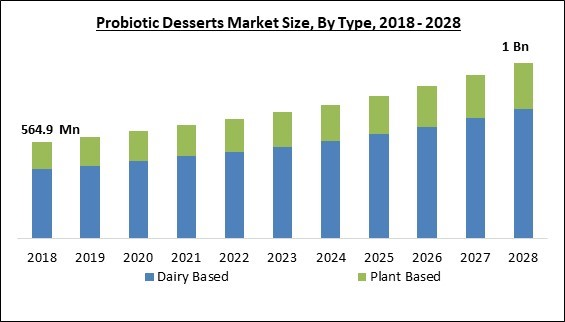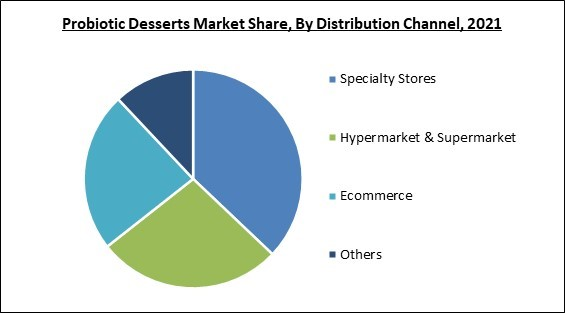The Global Probiotic Desserts Market size is expected to reach $1 billion by 2028, rising at a market growth of 6.6% CAGR during the forecast period.
Probiotic desserts contain live microorganisms called probiotics, identical to the good bacteria in the human stomach. The purpose of these desserts is to offer consumers a quick and delectable way to enhance digestive health. Yogurt, kefir, as well as fermented ice cream are a few typical examples of probiotic desserts. According to the National Institutes of Health (NIH), probiotics are live microbes likebacteria and yeasts similar to the germs in the human gut.
Therefore, they can positively affect health when ingested in sufficient quantities. Similarly, the World Health Organization describesProbiotics as'live bacteria that, when provided in sufficient proportions, impart a health benefit on the host.'Probiotic desserts might be a simple method to ingest probiotics. Additionally, sincenot all probiotic foods are created equally,the health advantages may differ depending on the kind and quantity of bacterial strains utilized.
Growing consumer interest in goods that promote digestive health and wellness is one of the trends in the probiotic desserts market. Probiotic desserts are a simple answer for people looking for quick and enjoyable ways to add probiotics to their diets as they become more conscious of how important gut health is. As more and more individuals focus on their health, the baking sector evolves and modifies to meet consumer demand.
People are looking for items with outstanding flavor and fine taste that are healthier, more practical, and have a growing market share. Since chilled dairy desserts are becoming increasingly popular, bakers are adding probiotics and prebiotics to their recipes. Consumers have become less interested in 'all indulgence desserts'today since it would divert them from their health objectives. Food manufacturers offer items with this mix as consumers seek nutritious advantages and a delicious flavor.
The market research report covers the analysis of key stake holders of the market. Key companies profiled in the report include General Mills, Inc., Chobani LLC, Danone, S.A., Fonterra Co-operative Group Limited, Meiji Holdings Co., Ltd., Lancashire Farm Dairies, Sovos Brands, Inc., Yofix Probiotics Ltd., and Forager Project, LLC.
Probiotic desserts contain live microorganisms called probiotics, identical to the good bacteria in the human stomach. The purpose of these desserts is to offer consumers a quick and delectable way to enhance digestive health. Yogurt, kefir, as well as fermented ice cream are a few typical examples of probiotic desserts. According to the National Institutes of Health (NIH), probiotics are live microbes likebacteria and yeasts similar to the germs in the human gut.
Therefore, they can positively affect health when ingested in sufficient quantities. Similarly, the World Health Organization describesProbiotics as'live bacteria that, when provided in sufficient proportions, impart a health benefit on the host.'Probiotic desserts might be a simple method to ingest probiotics. Additionally, sincenot all probiotic foods are created equally,the health advantages may differ depending on the kind and quantity of bacterial strains utilized.
Growing consumer interest in goods that promote digestive health and wellness is one of the trends in the probiotic desserts market. Probiotic desserts are a simple answer for people looking for quick and enjoyable ways to add probiotics to their diets as they become more conscious of how important gut health is. As more and more individuals focus on their health, the baking sector evolves and modifies to meet consumer demand.
People are looking for items with outstanding flavor and fine taste that are healthier, more practical, and have a growing market share. Since chilled dairy desserts are becoming increasingly popular, bakers are adding probiotics and prebiotics to their recipes. Consumers have become less interested in 'all indulgence desserts'today since it would divert them from their health objectives. Food manufacturers offer items with this mix as consumers seek nutritious advantages and a delicious flavor.
COVID-19 Impact Analysis
The demand for functional foods, nutraceuticals, nutritional supplements, and immunity-boosting foods like probiotic desserts increased during the pandemic due to rising awareness and understanding about using immunity-boosting supplements. In addition, the COVID-19 pandemic also compelled consumers to stock up on necessary and nutrient-dense foods like yogurt, kefir, and others, which raised the usage of probiotic products in the food and beverage industry. Therefore, the pandemic had a moderate impact on the probiotic desserts, as the disruptions to the supply chains impacted their distribution networks while the demand for these products increased.Market Growth Factors
Rising demand for functional foods
Governmental entities have approved relevant health claims based partly on research. As a result, probiotics continue to place a high priority on digestive health. Probiotics are currently one of the most adaptable components since consumers are increasingly looking for them for health reasons other than digestive health, such as immunity, oral health, and weight management. Enabling them to introduce their goods to new health categories gives market and market participants’ growth prospects.Creation of novel flavors and self-service business models
Self-serve eateries give patrons total control over toppings, flavors, and portion sizes, allowing them to choose and control their intake in line with their dietary needs. The ratio of self-serving outlets has increased significantly over the past few years compared to full-service companies. The fact that creations are priced in this model based on weights rather than toppings and tastes has an additional impact on consumer preference for this model. Owing to these advancements, consumers now prefer probiotic desserts over alternatives like regular ice cream, which will help the market grow in the upcoming years.Market Restraining Factor
Wrongful marketing or perception of the product
The demand for healthier and more useful food options among customers has significantly increased, but the unavailability of quality products deters customers from consuming probiotics in this form. Additionally, since consumers associate probiotic desserts with high-calorie or 'junk'foods, one of the greatest barriers to their diet inclusion is the customers’ perception of desserts as infrequent meals. Therefore, all these aforementioned factors may hamper the growth of the probiotic desserts market in the coming years.Application Outlook
Based on application, the probiotic desserts market is categorized into yogurt, kefir, ice cream, and others. The kefir segment procured a considerable growth rate in the probiotic desserts market in 2021. Kefir is a fermented milk beverage created from kefir grains, a particular kind of mesophilic symbiotic culture that resembles a thin yogurt. Products made from kefir contain nutrients in levels that range from minimal to large, including nutritional minerals, conjugated linoleic acid, essential amino acids, and vitamins, in amounts that are comparable to unfermented goat, cow, or sheep milk.Distribution Channel Outlook
On the basis of distribution channel, the probiotic desserts market is divided into Ecommerce, specialty stores, hypermarket & supermarket, and others. The specialty stores segment acquired the largest revenue share in the probiotic desserts market in 2021. Customers who shop at specialty stores receive top-notch customer service, thorough product descriptions, and knowledgeable advice. The emergence of specialized retail formats results from the retail sector's ongoing evolution, changes in customer behavior, and general lifestyle advancements around the globe. The increasing prominence and presence of specialty stores are propelling the growth of the segment.Type Outlook
Based on type, the probiotic desserts market is segmented into dairy based and plant based. The dairy based segment witnessed the maximum revenue share in the probiotic desserts market in 2021. The expansion of the segment is being driven by rising customer desire for wholesome and useful food products. Dairy based probiotic desserts are extremely common and demanded in many regions. Additionally, the widespread availability of facilities like self-serving frozen dessert stalls also sale dairy products.Regional Outlook
On the basis of region, the probiotic desserts market is analyzed across North America, Europe, Asia Pacific, and LAMEA. The Asia Pacific segment procured the highest revenue share in the probiotic desserts market in 2021. The growing popularity of probiotics has fuelled the demand for probiotic desserts in China and India. Increasing disposable income, shifting lifestyles, and the rising popularity of flavored yogurt are the main factors influencing the demand for such goods. Also, the development of new products and the rising demand for ready-to-eat meals contribute to the expansion.The market research report covers the analysis of key stake holders of the market. Key companies profiled in the report include General Mills, Inc., Chobani LLC, Danone, S.A., Fonterra Co-operative Group Limited, Meiji Holdings Co., Ltd., Lancashire Farm Dairies, Sovos Brands, Inc., Yofix Probiotics Ltd., and Forager Project, LLC.
Scope of the Study
By Type
- Dairy Based
- Plant Based
By Application
- Yogurt
- Kefir
- Ice Cream
- Others
By Distribution Channel
- Specialty Stores
- Hypermarket & Supermarket
- Ecommerce
- Others
By Geography
- North America
- US
- Canada
- Mexico
- Rest of North America
- Europe
- Germany
- UK
- France
- Russia
- Spain
- Italy
- Rest of Europe
- Asia Pacific
- China
- Japan
- India
- South Korea
- Singapore
- Malaysia
- Rest of Asia Pacific
- LAMEA
- Brazil
- Argentina
- UAE
- Saudi Arabia
- South Africa
- Nigeria
- Rest of LAMEA
Key Market Players
List of Companies Profiled in the Report:
- General Mills, Inc.
- Chobani LLC
- Danone, S.A.
- Fonterra Co-operative Group Limited
- Meiji Holdings Co., Ltd.
- Lancashire Farm Dairies
- Sovos Brands, Inc.
- Yofix Probiotics Ltd.
- Forager Project, LLC
Unique Offerings
- Exhaustive coverage
- The highest number of market tables and figures
- Subscription-based model available
- Guaranteed best price
- Assured post sales research support with 10% customization free
Table of Contents
Chapter 1. Market Scope & Methodology
Chapter 2. Market Overview
Chapter 3. Global Probiotic Desserts Market by Type
Chapter 4. Global Probiotic Desserts Market by Application
Chapter 5. Global Probiotic Desserts Market by Distribution Channel
Chapter 6. Global Probiotic Desserts Market by Region
Chapter 7. Company Profiles
Companies Mentioned
- General Mills, Inc.
- Chobani LLC
- Danone, S.A.
- Fonterra Co-operative Group Limited
- Meiji Holdings Co., Ltd.
- Lancashire Farm Dairies
- Sovos Brands, Inc.
- Yofix Probiotics Ltd.
- Forager Project, LLC










